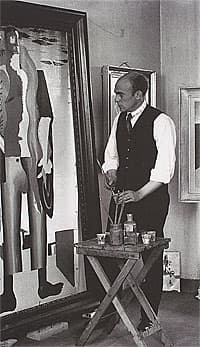Jean LURÇAT

Jean Lurçat (b Bruyères, France, 1 July 1892 – d Saint-Paul de Vence, France, 6 January 1966) began painting under Victor Prouvé at the Ecole de Nancy, in 1912. He subsequently moved to Paris to study at the Ecole des Beaux-Arts and later at the Académie Colarossi. At the beginning of the First World War, Lurçat enlisted in the French army but was discharged after being wounded, recovering at his parents’ home in Sens where, with his mother’s guidance he completed his first canvas stitched tapestry. He moved to Geneva and in 1921 received his first theatre commission, to design scenery and costumes for Celui qui reçoit des gifles for the Pitoeff company.
Between 1923 and 1925 Lurçat travelled in Spain, North Africa, Greece and Asia. During this time he worked in a Cubist and Surrealist style. But on seeing the fourteenth-century Gothic tapestry La tapisserie de l’Apocalypse at Château d’Angers in the early 1930s, Lurçat decided to devote himself exclusively to the design of tapestries. The first of these was made in 1933 on a high-warp loom at the internationally renowned Gobelins factory in Aubusson, France. In the same year he was commissioned by de Basil to produce designs for the set and costumes for the George Balanchine ballet Jardin public.
Lurçat worked tirelessly on modernising the ailing French tapestry industry. To this end, in 1939 the French government commissioned him to create a series of tapestries. In 1940 he wove twenty tapestries in the Tabard and Gobelins factories with the collaboration of André Derain and Raoul Dufy.
Unknown photographer
Jean Lurçat in his studio Villa Seurat, Paris 1926 unknown collection



